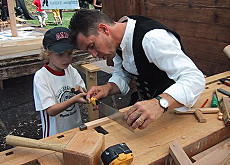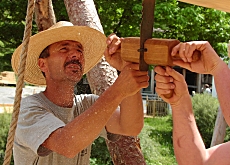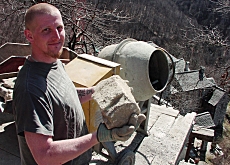Putting old skills and tools to work again

An archaeologist is using the most modern of tools to ensure that historical craftsmanship does not die out.
Simon Meyer has set up a database in the heart of rural Switzerland to link craftsmen, researchers and producers. He believes old skills have an important role to play in our automated and virtual age.
Meyer’s goal at Werkzeitraum, the Swiss Centre of Competency for Historical Craftsmanship, is to revive traditional techniques before they disappear forever; the art of making barrels, turning wood, shaping stone or weaving lace.
Located in the canton Lucerne town of Schüpfheim, the centre is in the same building as the museum that highlights many forgotten regional crafts. But to Meyer, the old tools on display represent more than curiosities from the past.
They show how skilled craftsmen contribute to the sustainable use of resources.
“Carpenters use only as much wood as appears in the finished product,” Meyer explains. “They use as little of the raw material as necessary because they are aware of wood’s real cost, and give a preference to local timber since it’s suitable for the climatic conditions here.”
To illustrate the way mass produced goods often work, he claims “the energy of an entire tree is needed to produce a single toothpick if the entire production process and transport is taken into account”.
The list of examples of how automation has replaced traditional craftsmanship is endless. But Meyer believes there is still a demand for handmade goods.
Before the potential can be realised, however, small tradesmen must win back respect, become better organised and learn to redevelop the one skill they have lost – the ability to market their talents and products.
Top price
The Swiss watch industry, particularly the companies making mechanical timepieces, has led the way in proving there is a strong demand for handcrafted goods that can fetch a top price.
To revive old skills, the Werkzeitraum is designing training concepts and developing marketing strategies for traditional crafts. The centre’s strength is its database of all the known tool types that were ever used in Switzerland, and about 1,000 contact addresses of crafts experts, producers, researchers and organisations.
The centre’s focus on carving out a future niche for traditional crafts has already led to some interesting ideas, such as convincing small tradesmen to introduce leasing schemes to make their goods, whether a tailor-made suit or solid wood table, more affordable in the short-term.
Meyer would also like to learn from traditional Mennonite and Amish communities in North America which have preserved and further developed ancient crafts they took with them when they fled Switzerland hundreds of years ago.
Visionary past
Another idea is to open a museum for the “visionary past” based on a fictional village called Neverwhere. Completely cut off from the rest of civilisation, the villagers have developed everyday objects in a different way.
Visitors to Neverwhere would play the role of the inhabitants and reinvent objects with the aid of real designers and craftsmen.
The head of Werkzeitraum believes rising energy prices will eventually heighten society’s ecological awareness and therefore increase demand for “authentic” goods with clear origins.
But the efforts of Werkzeitraum, a non-profit organisation partially supported by government funding, may be too little too late. Meyer’s fear is that “mankind loses the skills necessary to do what it has always done; adapt to new situations”.
The centre’s ultimate aim is to help preserve human values. “If we don’t, then we will lose something very fundamental. We would not be what we are today if we were not able to express ourselves through crafts.”
swissinfo, Dale Bechtel in Schüpfheim
The goal of the Swiss Centre of Competency for Historical Craftsmanship is “to research, preserve and convey historical craft skills”.
Included in the centre’s database are the names of experts who, for example, have such diverse skills that they can give advice on the reconstruction of a hypocaust system (ancient Roman method of heating a building) or repairing a horse saddle.
Werkzeitraum’s library includes old books, and periodicals as well as sketches and instructional booklets such as one describing the manufacture of parchment.
The centre is supported by the Swiss government and is a partner of various national and international non-profit organisations and institutions, including Unesco.
Unesco’s convention for the Safeguarding of Intangible Cultural Heritage came into force in 2006.
The UN body considers this as:
– oral traditions and expressions including language as a vehicle
– performing arts (traditional music, dance and theatre)
– social practices, rituals and festive events
– knowledge and practices concerning nature and the universe rituals
– traditional craftsmanship

In compliance with the JTI standards
More: SWI swissinfo.ch certified by the Journalism Trust Initiative




You can find an overview of ongoing debates with our journalists here. Please join us!
If you want to start a conversation about a topic raised in this article or want to report factual errors, email us at english@swissinfo.ch.